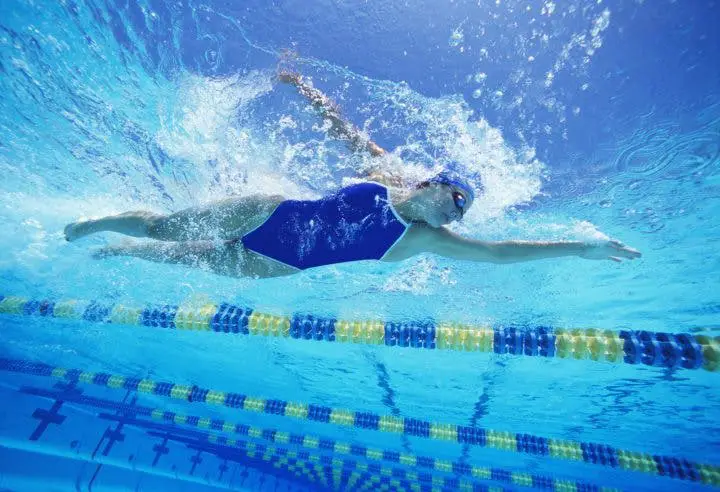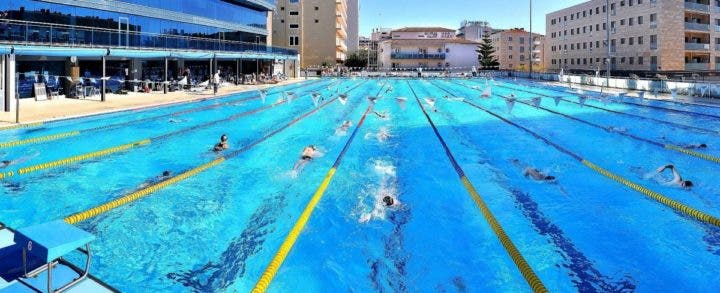In the world we live in today, it is difficult to progress with a limited time to train. It is hard but not impossible.
During the last two years that I have personally trained for swimming events, I have had the opportunity to experiment with different short duration training routines for swimmers, very effective in terms of training effects.
30 minutes of training in the pool can be turned into effective time, if you focus on what you should do from the moment you get to the pool and avoid unnecessary distractions.
3 30-minute swim routines
The first thing to consider when you have limited time to train is that you need to jump into action immediately . It may be that when you get to the pool you will meet fellow athletes with whom it is possible to chat. But you are not there to talk. You have little time and therefore you must enter the water as soon as possible to complete your training.
The warm-up that you will do at the beginning of each routine should be short, simply fulfilling the objective of raising your heart rate and getting the sensation of the water necessary for your brain to correctly register that you are in an inhospitable environment.

1. Fundamentals of swimming
When you propose to carry out a training session focused on the fundamentals, it means that the content of it will be focused on swimming all with an impeccable technique, focused on perceiving a special sensation of the water.
On days when you focus on working the fundamentals, the swims should be low to medium intensity. These sessions are perfect for focusing efforts on achieving excellent shoulder rotation, keeping your head stable throughout the time you are swimming, and emphasizing all the aspects that will help you propel yourself more effectively through the water.
For example, you could do the following workouts:
- 1 x 200 maintaining a good distance per stroke.
- 6 x 50 with tuba, concentrating on good shoulder rotation and proper head position, resting 20 seconds between each rep.
- 12 x 25 two repetitions of each style (butterfly, backstroke, breaststroke, crawl) resting 20 seconds between repetitions.
- 1 x 400 completing each portion of 100 meters progressively, that is, increasing speed and concentrating on correctly executing the submerged phase of the stroke.
- 1 x 200 soft swim to loosen the muscles a bit.

2. Aerobic capacity
The main purpose of aerobic capacity is to increase maximum oxygen consumption. In other words, capacity training increases the amount of energy we have available for swimming . In the case of aerobic capacity, this type of training increases the amount that we have available aerobically.
Aerobic capacity training also has the attribute of producing gains in the ability to activate slow-twitch fibers and in some minor cases, fast-twitch fibers as well.
- 1 x 150 heating
- 12 x 100 every 2 minutes, at a rate of 80% of maximum pulsations
- 1 x 150 soft swim to loosen the muscles a bit

3. Anaerobic threshold
The anaerobic threshold is the point at which our bodies begin to produce lactic acid faster than we can eliminate it. This results in the accumulation of lactate and consequently in fatigue. But to increase the anaerobic threshold we must understand what happens when we reach the anaerobic threshold.
Once we exceed the threshold, we begin to activate more fast-twitch fibers. These fibers produce their energy through the anaerobic energy system, which causes the body to produce more lactic acid than it can eliminate. To achieve improvements in the anaerobic threshold, we must learn to deal with both elements of this process; the recruitment of fast twitch fibers and the removal of lactate when it is being produced.
- 4 x 50 finishing fast the last 10 meters of each portion of 25 meters, resting 20 seconds between repetitions.
- 12 x 25 at running speed, resting 30 seconds between repetitions + 100 meters at an easy pace.
- 8 x 50 at sprint speed every 60 seconds.
- 1 x 400 soft swim to loosen up the muscles a bit.

How to achieve the desired training effects
The great American football coach, the North American Vince Lombardi immortalized the saying “Practice does not make perfect, only perfect practice makes perfect.” In swimming, to quickly improve your skills in the water you must focus on perfecting your technique. Perfecting swimming technique is tedious work and it takes time for us to begin to see the gains from it.
Once we begin to see that we have progressed technically, we can incorporate these improvements into our high-speed swimming. No matter the speed at which you swim, low, medium or fast, you should always use the proper technique so that you can improve your marks and mitigate the effects of exhaustion that are commonly created by the resistance that water exerts on our bodies.
Conclution
If you have little time to complete your swimming training, you must take into account the following points:
- Always consider doing a dynamic warm-up before jumping into the water. If you don’t have time, you can do it before heading to the pool from your home or workplace.
- You must optimize the time you have available , previously organizing everything you will need to carry out your 30-minute session.
- You must make sure that you have all the necessary equipment to swim, including swimwear, hat, glasses, fins, tuba, buoy and any other accessories you need.
- Write the content of your training in advance on a sheet of paper or have it saved on one of your electronic devices, so you only get proposed to jump into the water.
References
- Fernando Navarro Valdivieso. Aerobic endurance training in swimming. For Group About Training. [Revised May 2016]
- Alfonso Maltraba. Improve your anaerobic threshold. For triatlonweb.es. [Revised May 2016]
